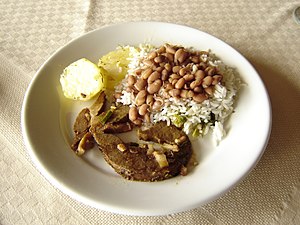| Revision as of 23:39, 5 May 2013 edit98.192.108.170 (talk) →South American termsTag: section blanking← Previous edit | Revision as of 23:39, 5 May 2013 edit undo98.192.108.170 (talk) →DescriptionTag: section blankingNext edit → | ||
| Line 3: | Line 3: | ||
| '''Rice and beans''' is a ] in many cultures around the world. It provides several important nutrients, and is widely available. See the ] for a number of ethnic dishes employing these two ingredients. | '''Rice and beans''' is a ] in many cultures around the world. It provides several important nutrients, and is widely available. See the ] for a number of ethnic dishes employing these two ingredients. | ||
| ==Description== | |||
| The dish usually consists of ] or ] accompanied by brown, red or black, dry ]s (typically '']'' or '']'') and ] in various ways. Different regions have different preferences. In ], for example, black beans are more popular in ], ] and ], while in most other parts of the country these are mostly only used in ]s. The ] specialty known as "]" is often accompanied by a side of smoked ] or a fried ]. | |||
| In many areas, rice and beans are often served side by side rather than mixed. Either way, they may be considered a meal, frequently with a topping of ] or ]. Meat or other ingredients are sometimes placed atop rice and beans or (less often) mixed into it. | |||
| ==History== | ==History== | ||
Revision as of 23:39, 5 May 2013
| This article needs additional citations for verification. Please help improve this article by adding citations to reliable sources. Unsourced material may be challenged and removed. Find sources: "Rice and beans" – news · newspapers · books · scholar · JSTOR (February 2013) (Learn how and when to remove this message) |

Rice and beans is a staple food in many cultures around the world. It provides several important nutrients, and is widely available. See the See Also section for a number of ethnic dishes employing these two ingredients.
History
The Americas
While beans are native to the Americas, rice is not. Rice was introduced to the Caribbean and South America by European colonizers at an early date with Spanish colonizers introducing Asian rice to Mexico in the 1520s at Veracruz and the Portuguese and their African slaves introducing it at about the same time to Colonial Brazil. More recent scholarship suggests that African slaves played a more active role in the establishment of rice in the New World and that African rice was an important crop from an early period. In either case, varieties of rice and bean dishes were a staple dish among the peoples of West Africa, and they remained a staple among their descendants subjected to slavery in the Spanish New World colonies and elsewhere in the Americas.
Nutritional significance
The dish is very nutritious. Rice is rich in starch, an excellent source of energy. Rice also has iron, vitamin B and protein. Beans also contain a good amount of iron and an even greater amount of protein than rice.
In addition, rice and beans are common and affordable ingredients, often available even when times are hard.
Culture
In Brazil, rice and beans are commonly eaten as everyday lunch, along with a different variety of meats and vegetables. It is also common to prepare dinner using the lunch leftovers. Brazil is the world leader in dry beans production and Latin American leader in rice consumption.
See also
- Louisiana Creole cuisine
- Gallo pinto, a Nicaraguan/Costa Rican version of rice and beans
- Arroz con gandules, a Puerto Rican version of rice and pigeon peas
- Platillo Moros y Cristianos, a Cuban version of fully mixed rice and black beans
- Beans on toast, a British cereal + beans dish
- Rice and peas, a Jamaican staple dish
- Kongbap, a Korean rice and beans dish
- Rajma, an Indian bean dish usually served with rice
- Mujaddara, a rice and lentils dish from Middle East
- Haitian cuisine
- Feijoada, Brazilian national dish
References
- Black Rice: The African Origins of Rice Cultivation in the Americas by Judith A. Carney
- National Research Council (1996-02-14). "African Rice". Lost Crops of Africa: Volume I: Grains. Lost Crops of Africa. Vol. 1. National Academies Press. ISBN 978-0-309-04990-0. Retrieved 2008-07-18.
{{cite book}}: Cite has empty unknown parameter:|origdate=(help); External link in|chapterurl=|chapterurl=ignored (|chapter-url=suggested) (help)
Bibliography
- Embrapa, Origem e História do Arroz and Origem e História do Feijão Template:Pt icon
- Arroz e Feijão: Uma dupla infalível, Camaquã Alimentos Template:Pt icon
External links
| Legume dishes | |
|---|---|
| |
| See also | |